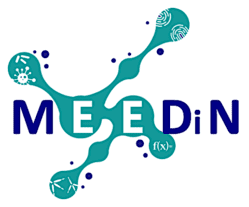Organic and chemical pollutions in the presqu'île du Cap Vert in Dakar is a challenging issue for the human well being and the environment. The aim of this project is to complement the data collection and analyses of pollutions in the coastal environment. This has a direct impact on the riverine populations and all the persons that are economical reliable from the ocean (fishermen, or recreational activities). More globally, the organisation of the Young Olympic Games in 2022 in Dakar, represents a big opportunity to convert the population for a better and safer environment for their futur.
Project funding: CIO-CNOSS 2019-2020
[Photo credit: Patrice Brehmer]
PAST & CURRENT PROJECTS
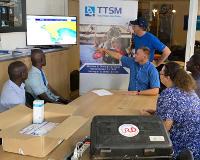
Collaborators: Bissoume SAMBE BA (Institut Pasteur de Dakar, Sénégal), Issa N'DIAYE (Institut Pasteur de Dakar, Sénégal), Amidou SONKO (CRODT-UCAD, IRD-LEMAR), Yoba KANDE (CRODT-UCAD, IRD-LEMAR)
learn more ...
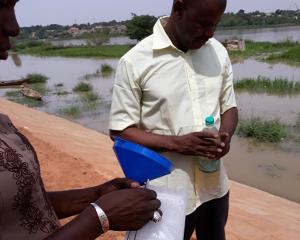
Collaborators: Bissoume SAMBE BA (Institut Pasteur de Dakar, Sénégal), Issa N'DIAYE (Institut Pasteur de Dakar, Sénégal), Julie GAUTHIER et Julien GRAVELEAU (UNICEF, Sénégal), Alama KEITA (UNICEF, Niger), Sani OUSMANE (CERMES, Niger), Enrico BERTUZZO (University of Venice, Italy)
learn more ...
Two main aspects of the cholera transmission were treated in this project. The first was the transmission modelling due to human mobility with a specific focus on Niger. The second was the longitudinal surveillance of selected environmental source of water for the population on Madarounfa and Kollo in Niger. It consisted of sample several water sources at regular time and evaluate the contamination by toxigenic Vibrio cholerae O1 by both, a rapid and simple dipstick test methodology on site, and by the PCR gold standard method in lab at CERMES.
Funding: UNICEF - ECHO Dakar (2017-2018)
[Photo credit : Issa N'Diaye]
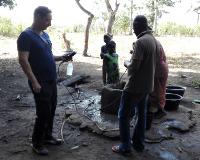
Collaborators: Bissoume SAMBE BA (Institut Pasteur de Dakar, Sénégal), Issa N'DIAYE (Institut Pasteur de Dakar, Sénégal), Julie GAUTHIER, Alassane TRAORE (UNICEF, Benin), Clément GLELE KAKAI (Ministry of Health, Benin), Placido CARDOSO (Ministry of Health, Guinea-Bissau).
learn more ...
The aim of this project was to compare the rapid dipstick diagnostic test for environmental surveillance both in non-epidemic and epidemic contexts. We proceeded to a longitudinale three sampling campaigns in Catio, Tombali region in Guinea-Bissau for the non-epidemic context. And one sampling campaign in Cotonou Benin and in Kalemi Democratic Republic of Congo, for the epidemic context. The sample protocol was applied with rapid test with 24 hours our room temperature enrichment and the PCR gold standard on enrichment broth.
Funding: UNICEF (2015-2016)
[Photo credit : ]
RELEVANT PUBLICATIONS Click here for the full list
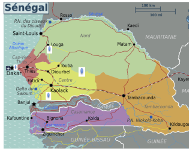
Frontiers in Microbiolgy,
click for abstract ...
Vibrio cholerae O1 is the causative agent of cholera with classical and ElTor, two well-established biotypes. In last 20 years, hybrid strains of classical and El Tor and variant El Tor which carry classical ctxB have emerged worldwide. In 2004–2005, Senegal experienced major cholera epidemic with a number of cases totalling more than 31719 with approximately 458 fatal outcomes (CFR, 1.44%). In this retrospective study, fifty isolates out of a total of 403 V. cholerae biotype El Tor serovar Ogawa isolates from all areas in Senegal during the 2004–2005 cholera outbreak were randomly selected. Isolates were characterized using phenotypic and genotypic methods. The analysis of antibiotic resistance patterns revealed the predominance of the S-Su-TCY-Tsu phenotype (90% of isolates). The molecular characterization of antibiotic resistance revealed the presence of the SXT element, a self-transmissible chromosomally integrating element in all isolates. Most of V. cholerae isolates had an intact virulence cassette (86%) (ctx, zot, ace genes). All isolates tested gave amplification with primers for classical CT, and 10/50 (20%) of isolates carried classical and El Tor ctxB. The study reveals the presence of atypical V. cholerae O1 El Tor during cholera outbreak in Senegal in 2004–2005.
Read more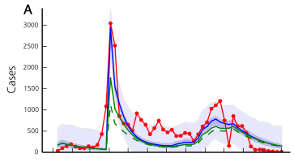
PNAS
click for abstract ...
The spatiotemporal evolution of human mobility and the related fluctuations of population density are known to be key drivers of the dynamics of infectious disease outbreaks. These factors are particularly relevant in the case of mass gatherings, which may act as hotspots of disease transmission and spread. Understanding these dynamics, however, is usually limited by the lack of accurate data, especially in developing countries. Mobile phone call data provide a new, first-order source of information that allows the tracking of the evolution of mobility fluxes with high resolution in space and time. Here, we analyze a dataset of mobile phone records of ∼150,000 users in Senegal to extract human mobility fluxes and directly incorporate them into a spatially explicit, dynamic epide- miological framework. Our model, which also takes into account other drivers of disease transmission such as rainfall, is applied to the 2005 cholera outbreak in Senegal, which totaled more than 30,000 reported cases. Our findings highlight the major influence that a mass gathering, which took place during the initial phase of the outbreak, had on the course of the epidemic. Such an effect could not be explained by classic, static approaches describing human mobility. Model results also show how concentrated ef- forts toward disease control in a transmission hotspot could have an important effect on the large-scale progression of an outbreak.
Read more
Frontiers in Microbiology
click for abstract ...
Understanding the seasonal emergence and reemergence of cholera is challenging due to the complex dynamics of different protagonists. The abundance of Vibrio cholerae, the causative agent of cholera and a natural inhabitant of aquatic environments, fluctuates according to abiotic, and biotic factors. Among the biotic factors, the zooplankton community dynamics has been suggested to play a pivotal role in the survival, persistence, and natural competence of V. cholerae. However, factors regulating V. cholerae population structure and seasonal dynamics are still not fully understood. Investigation of the temporal shifts and variability in aquatic community composition in relation to the occurrence or abundance of V. cholerae appears very promising yet remained underexplored. Recent advances in metagenomics, facilitated by high-throughput ultra deep sequencing, have greatly improved our ability for a broader and deeper exploration of microbial communities including an understanding of community structure, function, as well as inter- and intra-specific competitions. Here, we discuss possible areas of research focusing how combination of community ecology and metagenomic approaches could be applied to study the cholera system.
Read more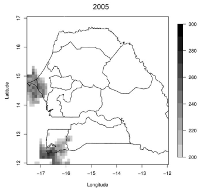
PLoS One
click for abstract ...
Cholera is an acute diarrheal illness caused by Vibriocholerae and occurs as widespread epidemics in Africa. In 2005, there were 31,719 cholera cases, with 458 deaths in the Republic of Senegal. We retrospectively investigated the climate origin of the devastating floods in mid-August 2005, in the Dakar Region of Senegal and the subsequent outbreak of cholera along with the pattern of cholera outbreaks in three other regions of that country. We compared rainfall patterns between 2002 and 2005 and the relationship between the sea surface temperature (SST) gradient in the tropical Atlantic Ocean and precipitation over Senegal for 2005. Results showed a specific pattern of rainfall throughout the Dakar region during August, 2005, and the associated rainfall anomaly coincided with an exacerbation of the cholera epidemic. Comparison of rainfall and epidemiological patterns revealed that the temporal dynamics of precipitation, which was abrupt and heavy, was presumably the determining factor. Analysis of the SST gradient showed that the Atlantic Ocean SST variability in 2005 differed from that of 2002 to 2004, a result of a prominent Atlantic meridional mode. The influence of this intense precipitation on cholera transmission over a densely populated and crowded region was detectable for both Dakar and Thiès, Senegal. Thus, high resolution rainfall forecasts at subseasonal time scales should provide a way forward for an early warning system in Africa for cholera and, thereby, trigger epidemic preparedness. Clearly, attention must be paid to both natural and human induced environmental factors to devise appropriate action to prevent cholera and other waterborne disease epidemics in the region.
Read more
EcoHealth
click for abstract ...
Vibrio cholerae, the causative agent of cholera, is a naturally occurring inhabitant of the Chesapeake Bay and serves as a predictor for other clinically important vibrios, including Vibrioparahaemolyticus and Vibrio vulnificus. A system was constructed to predict the likelihood of the presence of V. cholerae in surface waters of the Chesapeake Bay, with the goal to provide forecasts of the occurrence of this and related path- ogenic Vibrio spp. Prediction was achieved by driving an available multivariate empirical habitat model estimating the probability of V. cholerae within a range of temperatures and salinities in the Bay, with hydrodynamically generated predictions of ambient temperature and salinity. The experimental predictions provided both an improved understanding of the in situ variability of V. cholerae, including identification of potential hotspots of occurrence, and usefulness as an early warning system. With further development of the system, prediction of the probability of the occurrence of related pathogenic vibrios in the Chesapeake Bay, notably V. parahaemolyticus and V. vulnificus, will be possible, as well as its transport to any geographical location where sufficient relevant data are available.
Read more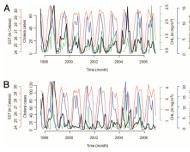
PNAS
click for abstract ...
The causative agent of cholera, Vibrio cholerae, has been shown to be autochthonous to riverine, estuarine, and coastal waters along with its host, the copepod, a significant member of the zooplankton community. Temperature, salinity, rainfall and plankton have proven to be important factors in the ecology of V. cholerae, influencing the transmission of the disease in those regions of the world where the human population relies on untreated water as a source of drinking water. In this study, the pattern of cholera outbreaks during 1998– 2006 in Kolkata, India, and Matlab, Bangladesh, and the earth obser- vation data were analyzed with the objective of developing a pre- diction model for cholera. Satellite sensors were used to measure chlorophyll a concentration (CHL) and sea surface temperature (SST). In addition, rainfall data were obtained from both satellite and in situ gauge measurements. From the analyses, a statistically significant relationship between the time series for cholera in Kolkata, India, and CHL and rainfall anomalies was determined. A statistically significant one month lag was observed between CHL anomaly and number of cholera cases in Matlab, Bangladesh. From the results of the study, it is concluded that ocean and climate patterns are useful predictors of cholera epidemics, with the dynamics of endemic cholera being related to climate and/or changes in the aquatic ecosystem. When the ecology of V. cholerae is considered in predictive models, a robust early warning system for cholera in endemic regions of the world can be developed for public health planning and decision making.
Read moreNEWS
MAIN COLLABORATORS
Montpellier
